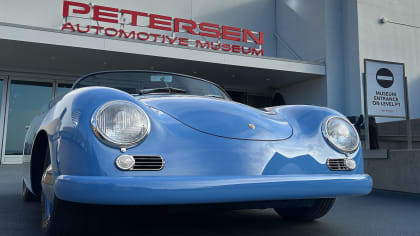THE BOOSTER CLUB
Driving the Ford EcoBoost cars
This article is from our archives and has not been updated and integrated with our "new" site yet... Even so, it's still awesome - so keep reading!
Published on Thu, Jul 25, 2013
By: The LACar Editorial Staff

Driving Impressions – A Little Engine With Something to Prove
By Sean Spear
Like the six-year old kid who got the most wanted Christmas toy, Ford Motor Company has been taking its EcoBoost line of engines everywhere and bragging about them to anyone who will listen. To date, Ford has put EcoBoost I4s and V6s in everything from the Fiesta to the venerable F-150; all the while daring any other kid on the block with a V8 to just try to beat them in a race. In 2009, Ford even got Motor Trend Magazine to run a comparo race through Loveland Pass, with a 3.5L EcoBoost V6-equipped Lincoln MKS facing-off against a Maserati Quattroporte, Jaguar XF 5.0, Mercedes E550, and a BMW 550i. Only the BMW came away without a bloody nose.
Following the Ford staff presentation, we were given the opportunity to put the newest EcoBoost powered vehicles through their paces. The auto-course was separated into three distinct driving areas. Ranging from a leisurely electric vehicle economy challenge, to a direct comparison test drive, and lastly to a quick-lap time competition, the areas were designed to collectively convey the range of capabilities that the EcoBoost series of engines brings to the Ford line-up.

Competition Brings Out the Best in Us
Putting aside my first instinct to shred rubber in the fastest way possible, I started with the ‘challenge’ designed to give me the yard-stick to measure these cars by. The EcoBoost Challenge Course gave me the opportunity to compare Ford’s midsize offering, the Fusion SE, and their small SUV, the Escape SE, against their perceived rivals. Each was paired against their respective class leaders, the Toyota Camry SE V6 and the Honda CRV EX. Jumping into the CRV first, I instantly felt relaxed. For some this may seem like exactly what you would want in a small ute, but here it meant that my pulse was unaffected. Despite a complete redesign in 2012, you would be hard-pressed to identify what has changed in the vehicle’s exterior style and interior ergonomics. Honda may have simply bet that they shouldn’t mess with a winning formula, but one wonders if Honda’s decision may hurt the vehicle’s long-term prospects against competitors who are increasingly upgrading the driver’s experience in even the most basic vehicles in their stables.
After some quick seating adjustments, I was on my way. The Honda’s seating position and visibility were very good; allowing me to easily read the road ahead. The first part of the course was a straight-line acceleration segment, followed by a small radius s-curve leg. The CRV’s 185-hp 2.4L I4 provided nice even pull on the straightaway, with no hint of struggle or thrashiness. Turn-in through the curves was smooth, but the ute’s anticipated bodyroll warns you quickly that you are reaching the car’s lateral limits. With this knowledge the remainder of the course was easy to chart, with the 180-turn and slalom sections passing uneventfully. The CRV drives comfortably and predictably, but also gives you no confidence that you can do anything with it other than daily routine driving.
Stepping into the Escape, I was honestly taken aback by the quality of materials and design. The dashboard screams technology at you; which in comparison to the 90s-style simple layout of the CRV, may be a little intimidating. Unlike many luxury vehicles these days, the cockpit doesn’t overwhelm you with more buttons and graphics then a savant can count in a single glance. However, Ford is clearly trying to make you feel like you are getting luxury comfort and capability in a still-inexpensive package. The designers were clearly in command when the Escape’s interior was laid-out, but the driver and their ability to just find the climate controls was not forgotten in the equation.
American manufacturers have always known how to do straight-line acceleration, so the 240-hp 2.0L I4 EcoBoost’s ability to spool up its turbocharger and quickly put the power to the pavement comes as no surprise. However, the Escape has a surprising lack of bodyroll through the s-curves and slalom. With the Escape’s slightly wider body and longer wheelbase, the better-distributed weight ends up making a noticeable difference in the ability of the car to sit level through a turn. Despite these confidence builders, the low-sloping hood tempered my sense of how late I could make my move into a turn. Without a clear indication of where the front of the car started, I found myself starting my turns a split-second sooner in order to avoid hitting the cones in the course. With Ford’s emerging common exterior styling theme, this issue more or less affected each of my Ford drives over the course of the day. Still, I had the feeling that like most vehicle idiosyncrasies, I might have gotten use to this the more I drove the vehicle.
The next set of comparisons involved the car class that most manufacturers are judged by, the midsize sedan. Similar to the CRV, the Toyota Camry also clearly conveyed comfort-first. However, a little more design acumen and technology were on display here. The Camry’s seating position and visibility were very good, although the seats themselves were not very supportive laterally (as I discovered later).
From a rolling start, the Camry’s acceleration had a noticeable hesitation, but then quickly ran towards the redline. It was as if the transmission was taking the time to ask me “Are you sure you want to go fast?”. Once obeying my wish, however, the Camry’s 268-hp V-6 pulled the car effortlessly down the straightaway. This performance then quickly died as soon as I started the turns. The Michelin all-weathers on the car’s four corners clearly were not up to the task. I experienced both understeer and tire-squeal at even the slowest speeds. The Ford staff actually came to the defense of the Camry, arguing that the extra-smooth asphalt made for easy tire screaming; but I didn’t experience this to the same degree with any other car I drove.
Even giving away 28 horsepower to the Camry, the Fusion had near-equal acceleration, but with instantaneous throttle response. Handling was spot-on, with slight but measured roll. This actually made the car easy to keep balanced in the turns. The better side-bolstered seats also improved the driving experience, keeping me firmly planted as I tossed the car into the short twists. While the seat fit me perfectly, I wondered if the same would be true for larger people. Like in the Escape, the dashboard controls are laid-out in an easy-to-access fashion, seamlessly blending with the console below it. The Fusion leaves you with a solid feel, and an engine up to the task.

Ben Franklin Would Be Proud
Still forestalling my inner racer, I made my way over to the Electrics. In the Hypermile Challenge Course, Ford challenged drivers to complete this variable speed course with the goal of eliciting the highest overall gas mileage reading possible. Two of the cars were ‘series-parallel’ hybrids (think your standard Prius); the Fusion Hybrid and the C-Max Hybrid. Both claim an average of 47 MPG for both City and Highway driving using the 1.6-Liter EcoBoost engine mated to a 35-kWh electric motor. Another two cars were plug-in Electric Vehicles (EVs), the Fusion Energi and C-Max Energi. In this configuration, the gas EcoBoost engine acts as a battery-recharging generator (think your standard Volt). Both of these cars claim an average of 150 MPGe (roughly the equivalent of 100 MPG).
To ease into the test, I started with the Hybrids. The Fusion Hybrid’s ride was comparable to the ‘regular’ gas-powered only version. Each of these EV models had (additional) in-dash graphics designed to encourage your most efficient driving habits. With their constant actions, these graphics would be very distracting to some, and a fun little game to others. While I needed them for the driving efficiency challenge, I also was thankful that Ford built in the ability to turn them off.
Despite the greater comfort in the Fusion (the C-Max felt and drove a little more like an econobox), I found that it seemed easier for me to maintain my speed, and balance the regenerative braking when needed. My best mileage was 58.1 MPG in the C-Max Hybrid, with the Energi version doing nearly twice that figure in ‘Electric Only’ mode.
Given that the engines, power, features, and fuel economy for the Fusions and C-Maxs were the same, I believe the choice would come down to whether you want everyone to know that you drive an EV (the C-Max), or you’d rather be a little less overt (the Fusion). Either way, it is hard to argue with the cost-saving benefits of these cars of the future, here today.

Caution to the Wind
Saving the best for last in my book, I quick-stepped over to the ST Performance Academy station. After listening as attentively as possible to the Instructor’s warnings and tips, I was ready. I elected to hop into the Focus ST first. Equipped with the top-of-the-line 2.0L I4 making 252 horsepower, this car is designed to emphasize speed over high MPG. Nevertheless, the engine still puts out a respectable 23 City and 32 Highway MPG. I settled into the nicely bolstered seat and adjusted the steering wheel to sit just above my lap, allowing my forearms to sit perfectly horizontal for the best visibility and turning rotation possible. Last minute words from the pace instructor were to take your first lap to get use to the car, and then really push to get your best time in the second. Getting below 38 seconds would be considered good.
Taking his advice, my first lap was testing the turn-in and apex hugging of the car. The Focus ST benefits from a tall 1st gear, giving you a smooth build-up of speed before moving into second (where I stayed for the remainder of the lap). In the turns, steering motion was softer than expected, but predictable. Traction Control consistently cut in fairly early, but it proved not to be a heavy damper. I was able to release it with a tap of the brakes and re-engage the power through the turns. With the preliminaries out of the way, I dove into the second lap with a little more confidence. Power build up continued to be good, but I had to dump more going into turns to avoid full Traction Control engagement. This meant tapping the brakes a little harder on entry and mashing the accelerator upon nearing the apexes. Once completing a straight acceleration to the finish, my time came in at 35.8 seconds.
With the new 2014 Fiesta ST making only 197 horsepower, I thought that the 35.8 was going to be my best time. The first clue that this run might be different was the prominent stitching in the seat back, saying “Recaro”. I also found it easier to find the perfect steering wheel placement. After getting cleared to go, I immediately pushed the car. The Fiesta was noticeably quicker off the line and more responsive to throttle input in the turns. Traction Control was still noticeable, but not as pronounced as in the Focus ST. Most importantly, steering was spot-on. I felt like all I had to do was point and shoot. I crossed the finish sensor at 34.4 seconds. The best time of the entire press group was 32.3, making me believe that I could get closer to the day’s best if I could just somehow get more time behind the wheel of the Fiesta ST.

Takeaways On the drive home, it dawned on me that I drove eight car models (four EVs, a standard sedan and a standard small SUV, and a couple hot-hatches) that all essentially shared just two engines. The numbers tell the story: 178 to 252 horsepower, and 23 City MPG to 100 Combined MPG depending on configuration. The fact that Ford can get such a range of utility based upon some relatively minor tweaks to a 1.6L block and a 2.0L block is noteworthy. It is clear the auto industry worldwide is moving away from big engines. It is also not hard to see why when you can get these types of performance and economy figures out of powerplants like these. Like that little boy with the best Christmas toy, you can’t blame Ford for bragging. To go to BOOSTER CLUB – Tech talk on the Ford EcoBoost, click here For more information about the Ford EcoBoost Challenge Drive Experience, click here.




